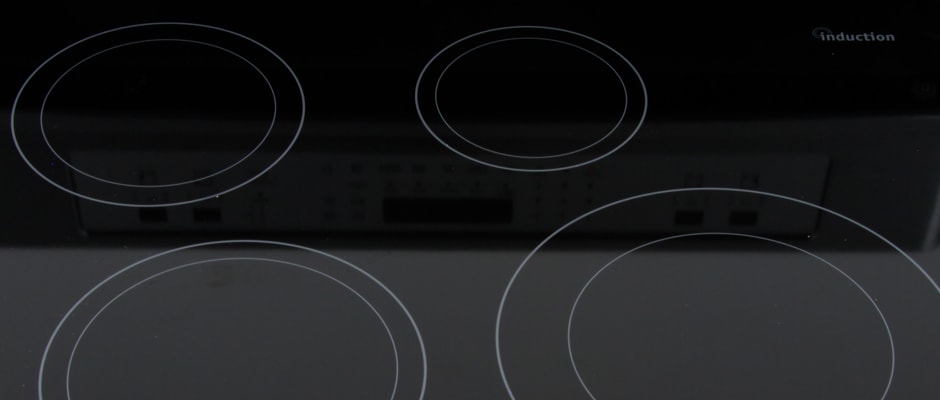Pros
Cons
Introduction
Design & Usability
{{section_header}}{{section.name}}{{/section_header}}
The Toyota Camry of ranges.
The {{product.name}} plays it safe with a vanilla mid-level range design. Instead of moving the rangetop controls to a more convenient location, Frigidaire has left the buttons (alas, no knobs) on the backsplash, so be careful when reaching over the stove. For the oven, Frigidaire unfortunately has joined Samsung in including gourmand-insulting buttons for "pizza" and "chicken nuggets" on the control panel.
The 6.0 cubic foot self-cleaning oven has four racks, rather than the typical two or three. It's important to note that it's much easier to clean an induction rangetop than anything else. It's a flat surface like electric, but it doesn't get hot itself—only the pan gets hot—so food doesn't get baked on.
{{photo_gallery "Vanity", "Front", "Rangetop Controls", "Oven Controls", "Burners 1", "Burners 2", "Burners Cleaning", "Upper Oven", "Upper Oven Detail", "Oven Detail", "Lower Oven Detail", "Lower Oven", "Drawer", "Broiler",}}
Rangetop
{{section_header}}{{section.name}}{{/section_header}}
The same induction performance we know and love.
Induction rangetops consistently deliver stellar performance, so it's no surprise we recorded near-perfect boiling, simmering, and searing results in our tests. Of course, the downside to all induction cooktops is that you need to make sure a magnet sticks to all of your pots. If that's not the case, you just might find that easier cleanup, better performance, and a clean look are worth updating your cookware.
Oven, Broiler, & Convection
{{section_header}}{{section.name}}{{/section_header}}
At this price, a middling oven is acceptable.
While it's certainly not as impressive as the rangetop, we're not counting out this range just because of its oven. We've seen ranges with marvelous induction rangetops fail completely in the oven department, so we welcome the {{product.name}}'s middling performance. The convection and conventional 350°F settings do alright in averaging the proper temperature, but the temperature fluctuation was greater than 20ºF too hot or too cold — the standard we like to see for evenness. Variation wasn't that far from the ideal, but it wasn't as good as it could be.
Conclusion
{{section_header}}{{section.name}}{{/section_header}}
We'll give this range a nod, but you might do well to wait for a sale.
Even waiting for a sale, there aren't that many induction ranges to choose from under $2,000. So when a decent one comes along, we're happy about it. This one's MSRP is $2,049, but we found it on sale regularly for under $1,700, which makes it one of the most affordable induction ranges on the market.
The only major weakness was the oven temperature variance, which we'd liked to have been reduced. It's only a fatal flaw for the most serious bakers, but the average user likely won't notice, especially in the face of the rangetop and price. However, if you can hold on a bit longer, it might be worth waiting, since this is a growing market here in the U.S. The selection can only get bigger, and the prices can only fall.
From Our Lab
{{section_header}}{{section.name}}{{/section_header}}
Like most induction ranges, we found incredible rangetop results—an average of 3.4 minutes to boil six cups of water—superior to most of the gas and electric competition. With all the concentration, neglect of the oven often produces a hole in the performance. The {{product.name}} wasn't immune to this induction trope, but its Achilles heel may not be a dealbreaker.
Oven Performance
{{section_header}}{{section.name}}{{/section_header}}
Middling—not bad—oven performance.
Set to 350°F the oven averaged 359°F (355°F with convection fan), which is reasonably close to the target. However, the oven temperature did fluctuate substantially, operating in a rather large 54°F window. Again the convection fan slightly moderated the variance down to 50°F, making it the better choice if the cuisine allows for convection.
At 198°F, the keep-warm temperature was hotter than the 170°F we liked to see, but it stayed very constant throughout the test. The maximum temperature setting of 500°F yielded an average of 516°F from our sensors, but satisfied us with low variance.
{{photo_gallery "Primary Oven Keep-Warm", "Primary Oven 350F", "Primary Oven Max", "Secondary Oven Convection", "Oven Variance"}}
Rangetop Performance
{{section_header}}{{section.name}}{{/section_header}}
Restaurant-worthy performance.
Instead of sacrificing control for temperature range—gas for electric—induction really makes it so you don't have to. Since induction burners don't heat up themselves, they can bring water froma boil to a standstill in seconds, unlike many electric ranges. But like electric, three of the burners hit searing numbers above 560°F, and all burners could run under 113°F. That's low enough to melt chocolate without a double boiler! Speaking of boiling, the front two elements teleported six cups of water to a boil in under three minutes. The rear two weren't too shabby—under four and five minutes for the left and right respectively.
{{photo_gallery "Waterboil", "Simmer"}}
Broiler
{{section_header}}{{section.name}}{{/section_header}}
Generally, people prefer broilers with more twisty elements—8-pass being the elite standar—as they distribute the high temperatures more quickly and evenly. However, the {{product.name}}'s 6-pass broiler handled itself better than many 8-pass models, shooting to 600°F in just four minutes.
Meet the tester
Ethan writes reviews and articles about science for Reviewed.com, and edits the Science Blog. He's originally from Vermont and thinks the bicycle and guitar are examples of perfected technology. Prior to Reviewed.com, he studied furiously at Middlebury College.
Checking our work.
Our team is here to help you buy the best stuff and love what you own. Our writers, editors, and experts obsess over the products we cover to make sure you're confident and satisfied. Have a different opinion about something we recommend? Email us and we'll compare notes.
Shoot us an email

